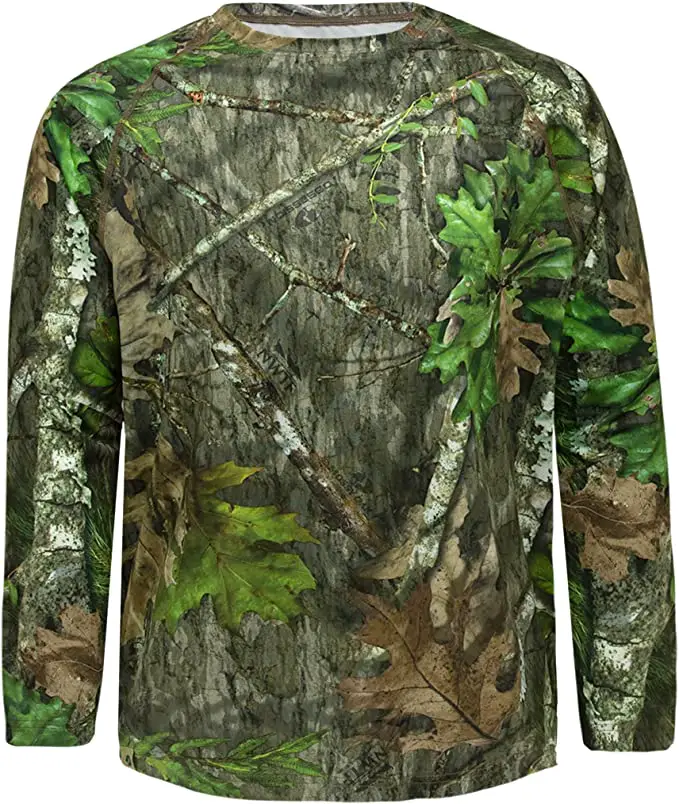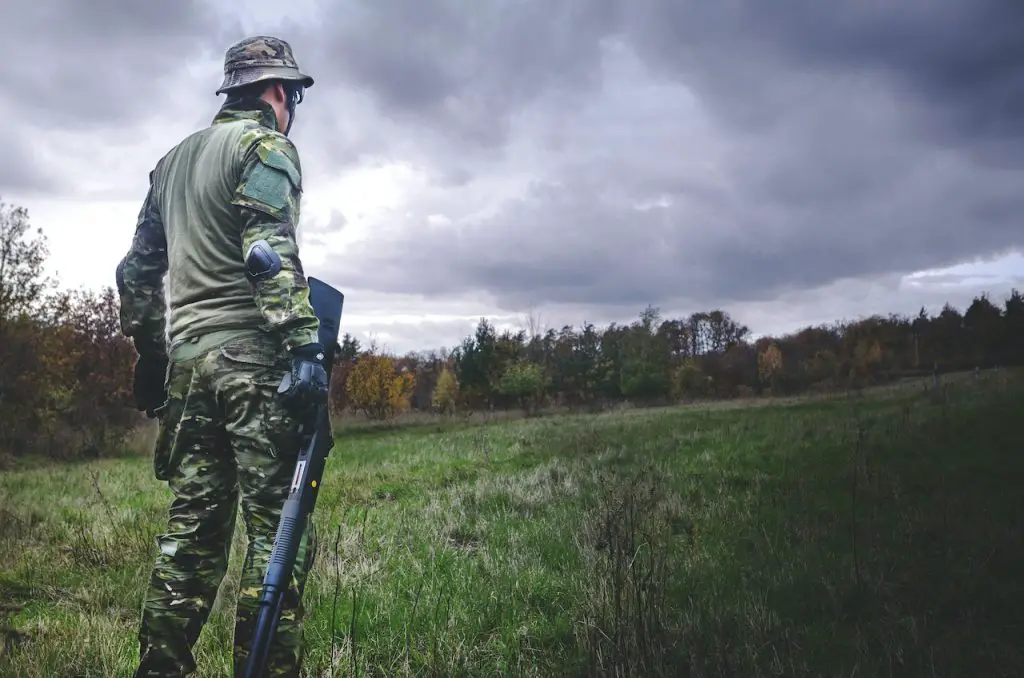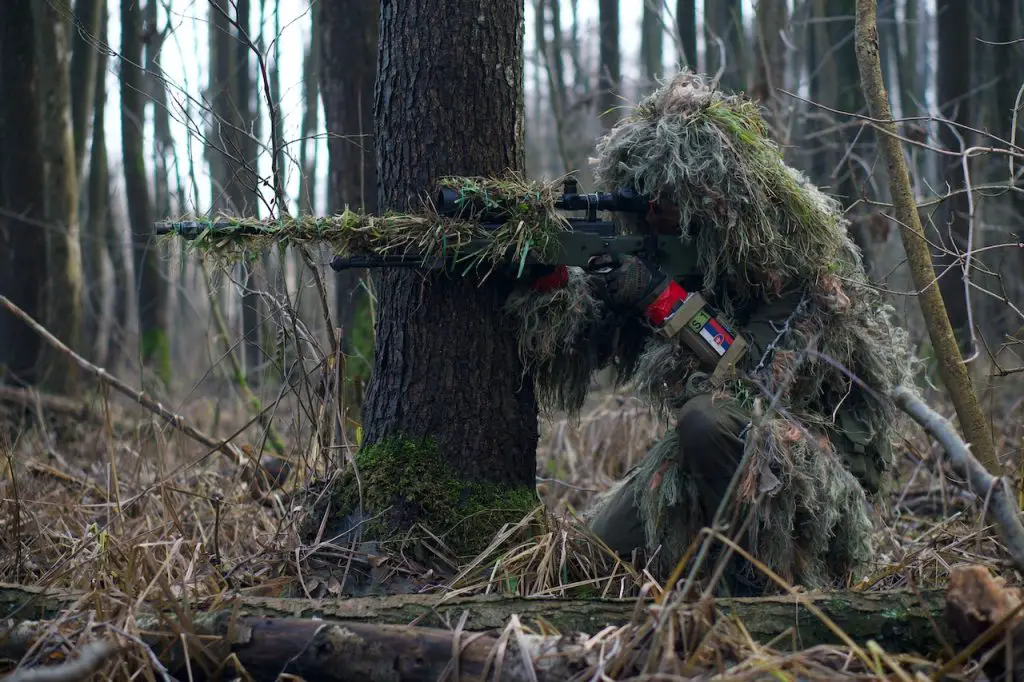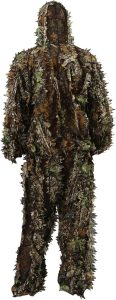What Is The Best Camo For Hunting?
Camo, short for camouflage, is a crucial element in hunting. It’s a technique that hunters use to blend in with their surroundings and go undetected by their prey.
The right camo can mean the difference between a successful hunt and going home empty-handed.
However, with so many options available on the market, it can be challenging to decide which camo is best for your hunting needs.

In this article, we will explore the different types of camo patterns available and the factors to consider when selecting the best camo for your hunting environment.
Additionally, we will provide insights on camo clothing and accessories, other camo techniques, and tips for camo maintenance.
The Purpose of Camouflage for Hunting
Camouflage, or camo for short, is a technique used to conceal oneself or an object in a natural environment.
Camo has been used for centuries by hunters and military personnel to blend in with their surroundings and avoid detection.
In hunting, the purpose of camouflage is to make the hunter less visible to game animals, allowing them to get closer and increase their chances of a successful hunt.
The effectiveness of camouflage for hunting depends on several factors, such as the terrain, season, and game species being hunted.
For example, a hunter may choose a camo pattern that mimics the colors and patterns of the leaves and branches in a wooded area during the fall season. This can help the hunter blend in with their surroundings and make it more difficult for game animals, such as deer or turkey, to spot them.
Another important factor in the effectiveness of camouflage is movement. Even with the best camo gear, a hunter who moves too quickly or makes sudden movements can still be detected by game animals.
To overcome this, hunters often use other camo techniques, such as staying still, using tree stands or ground blinds, and carefully selecting their approach and shooting positions.
In addition to concealing the hunter, camo can also be used to cover up the scent of the hunter. Game animals have a keen sense of smell and can detect human scents from a distance.
By using scent control products and cover scents, hunters can help mask their scent and avoid detection by game animals.
Types of Camo
Sticks and Leaves” (Mimicry) Camo Patterns “
Sticks and leaves, also known as mimicry camo patterns, are designed to imitate the patterns and colors of the natural environment in which the hunter is operating.
These patterns use a mix of browns, greens, and grays to create a random pattern that resembles sticks, leaves, and other natural elements.
The idea behind this type of camo is to break up the outline of the hunter and make them blend into the background, making it difficult for game animals to spot them.
Mimicry camo patterns are best used in wooded areas or areas with heavy foliage, as they mimic the natural surroundings of these environments.
They are also effective during the fall season when leaves are changing colors and falling from trees. By using a mimicry camo pattern, hunters can make themselves virtually invisible to game animals and increase their chances of getting closer for a clean shot.
Some of the best-selling models of mimicry camo patterns include the Realtree Edge, Mossy Oak Break-Up Country, and Sitka Gear Subalpine.
These patterns are designed to blend into a variety of wooded and foliage-heavy environments, and they are made with high-quality materials that are durable and effective.
- Realtree Edge – One of the most popular traditional camo patterns, Realtree Edge, has a mix of natural earthy colors such as brown, green, and tan. The pattern incorporates leaves and branches in its design, making it an excellent choice for hunting in forests and wooded areas.
- Mossy Oak Break-Up Country – Mossy Oak Break-Up Country features a combination of bark, leaves, and limbs to create a pattern that is ideal for hunting in thick vegetation. The pattern’s realistic 3D effect helps hunters blend in seamlessly with the environment, making it harder for game animals to detect them.
Overall, mimicry camo patterns are an excellent choice for hunters who are operating in wooded areas or areas with heavy foliage. They are designed to mimic the natural environment and make the hunter blend into the background, making it difficult for game animals to spot them.

B. Break Up Camo Or Digital Camo Patterns
Digital camo patterns are a newer generation of camo designs that have gained popularity in recent years.
They use computer-generated pixelated designs to create a more seamless blend into the environment, making them ideal for hunting in rocky or open terrain where traditional camo patterns may not work as effectively.
Breakup camo differs from mimicry camo as it utilizes colors and shapes rather than actual elements of nature in the design to achieve concealment.
While humans may find it easier to distinguish this camouflage, it’s important to remember that the purpose is to hide from the animal being hunted, and animals, particularly big game, don’t see the world as humans do.
- Kryptek Highlander – Kryptek Highlander features a complex design that uses multiple shades of green, brown, and tan. The pattern’s unique design creates a 3D effect, which helps break up the hunter’s outline, making them harder to detect. It’s ideal for hunting in rocky terrain or areas with sparse vegetation.
- Sitka Gear Optifade Open Country – Optifade Open Country is a digital camo pattern that features a mix of neutral colors such as gray, tan, and brown. The pattern’s unique design breaks up the hunter’s outline, making them blend in seamlessly with the surrounding environment. It’s ideal for hunting in open terrain, such as mountains and plains.
C. Natural Camo Patterns
Natural camo patterns are designed to match the specific terrain and vegetation found in a particular hunting location.
They are the most challenging camo patterns to replicate as they need to match the colors and patterns unique to a particular location.
- King’s Camo Desert Shadow – King’s Camo Desert Shadow is a natural camo pattern that features sandy colors and patterns that blend in seamlessly with the desert environment. The pattern’s unique design breaks up the hunter’s outline, making them blend in seamlessly with the surrounding environment. It’s ideal for hunting in arid and desert regions.
- Realtree Max-5 – Realtree Max-5 is a natural camo pattern designed for waterfowl hunting. The pattern’s unique design features a mix of cattails, reeds, and other vegetation found in marshy areas. The pattern’s neutral colors match the environment, making hunters blend in with their surroundings, making them harder to detect by game animals.
D. Large Contrast / Abstract Camo Patterns
Large contrast/abstract camo patterns, also known as disruptive patterns, use high-contrast colors and abstract shapes to break up the outline of the hunter and create a disruptive effect.
These patterns are designed to be effective in a variety of environments, including open fields, rocky terrain, and desert areas.
Large contrast/abstract camo patterns are best suited for hunters who operate in environments where there is little to no foliage, such as grassy fields, rocky hillsides, or sandy deserts.
These patterns use bold, high-contrast colors to break up the outline of the hunter and make it difficult for game animals to detect their presence.
Some of the best-selling models of large contrast/abstract camo patterns include the KUIU Verde camo, Sitka Gear Optifade Open Country, Kryptek Highlander, and Under Armour Ridge Reaper Barren.
These patterns are designed with high-quality materials that are lightweight, durable, and effective in a variety of hunting environments.
E. Traditional Camo Pattern
The “frog” pattern, which gained popularity in the 1950s, was quickly adopted by the hunting community and is now considered a more traditional form of camouflage.
However, this type of pattern is now considered somewhat obsolete and was quickly abandoned by the U.S. military. While it may be visually appealing and have nostalgic value, it does not provide the same level of concealment as more modern camo patterns.
The “frog” pattern offers the least amount of concealment and should only be used by individuals who require minimal camouflage.
Traditional camo patterns may be suitable for rifle hunters who remain far away from their prey and require less protection. However, for hunters who need to get closer to their prey, such as bow hunters, it is important to consider more modern and effective camo patterns that provide a higher level of concealment.
F. 3D Camo
The use of 3D camo patterns among hunters is relatively rare and considered a specialized type of camouflage.
One of best selling 3D camo is leafy camo hunting ghillie suit that is specifically designed to help hunters blend in with their environment.
The suit is made up of a mesh shell and synthetic thread that mimics natural foliage, providing excellent concealment in a variety of outdoor environments.
The suit is typically made up of multiple pieces, including a jacket, pants, and a hood that covers the entire head and face. The synthetic threads can be customized to match the environment, with different colors and textures available to create the most natural look possible.
One of the main advantages of a Camo Ghillie Suit is its ability to provide complete coverage and concealment, even in dense vegetation.
The suit’s three-dimensional design creates an illusion of depth and texture that helps hunters blend in seamlessly with their surroundings, making it difficult for game animals to detect their presence.
However, the Camo Ghillie Suit can also be quite heavy and cumbersome, making it challenging to move around and stay comfortable during extended hunting sessions.
Additionally, the suit requires careful maintenance to ensure that the synthetic threads remain in good condition and continue to blend in with the environment over time.
Additional Resources To Choose Hunting Camo:
Factors to Consider- Selecting Camo For Hunting
When selecting the best camo for hunting, there are several factors to consider, including the hunting environment, time of year, weather conditions, visual acuity of game species, and personal preference and comfort.
Hunting Environment
The hunting environment plays a significant role in determining the best camo pattern.
A hunter should choose a camo pattern that matches the environment they’ll be hunting in. For instance, a camo pattern designed for hunting in the forest may not work well in open fields or rocky terrain.
Time of Year and Weather Conditions
Camo patterns should be selected based on the time of year and weather conditions.
For instance, darker camo patterns may be suitable for hunting during the fall, while lighter camo patterns may work better during the spring and summer months.
It’s also important to consider the weather conditions. A camo pattern designed for cold weather may not be suitable for hunting during the summer months.
Visual Acuity of Game Species
Different game species have different levels of visual acuity. For instance, deer have excellent visual acuity and can detect even the slightest movement.
A camo pattern that works well for deer hunting should be designed to break up the hunter’s outline and blend in seamlessly with the surrounding environment.
In contrast, birds may not have as sharp of visual acuity and may not require as much camouflage.
Personal Preference and Comfort
Personal preference and comfort should also be taken into account when selecting a camo pattern.
Hunters should choose a pattern that they feel comfortable wearing and matches their personal style.
Camo patterns come in various colors and designs, so hunters should choose one that they like and feel confident wearing.
Additional Considerations
Other factors to consider when selecting a camo pattern include the type of hunting equipment being used, the hunting method, and the hunting location.
For instance, hunters using a bow may require a different camo pattern than those using a rifle. Additionally, hunters using a ground blind may require a different camo pattern than those hunting from a tree stand.

Camo Clothing and Accessories
In addition to selecting the right camo pattern, hunters should also consider the type of clothing and accessories they will need for a successful hunt.
1. Camo Clothing:
Camo clothing is essential for blending in with the environment and reducing the hunter’s visibility to game species.
When selecting camo clothing, hunters should consider the weather conditions, hunting location, and personal comfort.
Camo clothing comes in a variety of styles and designs, including jackets, pants, shirts, and full-body suits.
The best-selling camo clothing in the market include:
- Sitka Gear Men’s Fanatic Hoody: This is a popular choice for hunters who want to stay warm and comfortable during the hunt. It features a camo pattern that is designed to blend in with the forest environment.
- Under Armour Men’s Camo Early Season Field Pants: These pants are designed for early season hunts and feature a lightweight and breathable fabric that keeps hunters cool in warmer weather.
- Nomad Men’s Harvester Hunting Jacket: This jacket features a camo pattern that is designed for use in the fall and winter months. It is made of a waterproof and breathable fabric that keeps hunters warm and dry in wet conditions.
2. Camo Accessories
Camo accessories can help hunters stay concealed and comfortable during the hunt. Some popular camo accessories include:
- Camo Hats: A camo hat can help reduce the hunter’s visibility and protect their head from the sun.
- Camo Gloves: Camo gloves can help reduce the hunter’s visibility and protect their hands from the cold and elements.
- Camo Face Masks: A camo face mask can help reduce the hunter’s visibility and protect their face from the elements.
3. Hunting Boots
Hunting boots are an essential part of a hunter’s gear, as they provide support and protection for the feet during long hunts.
When selecting hunting boots, hunters should consider the terrain they will be hunting on, the weather conditions, and their personal comfort.
Camo hunting boots come in a variety of styles and designs, including rubber boots, insulated boots, and lightweight boots.
The best-selling camo hunting boots in the market include:
- LaCrosse Men’s Alphaburly Pro 18″ Hunting Boot: These boots are designed for use in wet and muddy conditions. They feature a camo pattern that is designed to blend in with the surrounding environment and a neoprene lining that provides insulation in cold weather.
- Irish Setter Men’s Vaprtrek Hunting Boot: These boots are designed for use in all types of weather conditions. They feature a camo pattern that is designed to blend in with the surrounding environment and a waterproof and breathable fabric that keeps hunters dry and comfortable.
With the right camo gear, hunters can stay concealed and comfortable during the hunt and increase their chances of success.

Should I Always Wear Camo for Bowhunting?
As with most things in hunting, the answer to whether you should always wear camo for bowhunting is: it depends.
Experienced hunters may argue that they have had success hunting without camo, and this is certainly possible. However, for beginners, wearing camo can provide a significant advantage in their hunting mission.
Camo clothing can help conceal you from your prey, minimizing the chance of them spotting you in your hideout. This can be especially important when hunting from a treestand, where your movements are more likely to be detected.
That being said, there are situations where camo may not be the best choice. For example, if you will be hunting from a ground blind, experts recommend wearing black clothing to better blend in with the shadows.
Ultimately, the decision of whether or not to wear camo will depend on the specific hunting situation and personal preference. While it may not be necessary in every case, camo can certainly provide a useful advantage in many bowhunting scenarios.
How Can I Know For Sure That My Camo Pattern Is Effective?
To ensure the effectiveness of your camo pattern, start by choosing a design that blends in with the terrain. For instance, a gray and white camo suit would be ideal for hunting in the snow, while a pattern featuring bark, leaves, and branches would work well in a forest.
Once you have the right camo pattern, test it out with the help of a friend. Put on your camo and sit in the spot where you plan to hunt. Ask your friend to take a picture of you from several yards away to see if you blend in with the surroundings or stand out.
If you achieve the desired level of camouflage, you can confidently plan your hunting trip. Remember that the effectiveness of your camo also depends on factors such as movement and scent control, so make sure to take those into account as well.
Can Deer See Blaze Orange Hunting Vests?
Deer have a limited ability to perceive colors and their vision is more attuned to detecting movement and contrast.
While blaze orange hunting vests are highly visible to humans, they can appear as a dull gray or brownish color to deer due to their color blindness and different visual perception.
In this case Breakup (digital) camo patterns are considered the most effective for hunting whitetails as they help to blend the hunter’s outline into the environment.
While deer may not easily detect colors, they are very sensitive to movement, which is why breakup camo patterns work well in reducing sudden movement and making the hunter less noticeable to their prey.
Other Camo Techniques
While selecting the right camo pattern and gear is essential, there are other camo techniques that hunters can use to increase their chances of success.
Scent Control
Scent control is an important aspect of camo that is often overlooked. Game animals have a keen sense of smell, and a hunter’s scent can give away their location. Hunters can use scent control products, such as scent-blocking sprays and scent-free soaps, to reduce their scent and increase their chances of success.
Cover Scents
Cover scents are another technique that hunters can use to reduce their scent and increase their chances of success. Cover scents are natural scents, such as pine or cedar, that hunters can use to mask their own scent and blend in with the environment.
Tree Stands and Ground Blinds
Tree stands and ground blinds are tools that hunters can use to stay concealed and increase their chances of success. Tree stands are elevated platforms that hunters can use to gain a better view of the surrounding area and reduce their visibility to game species. Ground blinds are camouflaged shelters that hunters can use to stay concealed on the ground.
Movement and Silhouette
Movement and silhouette are two factors that hunters should be aware of when using camo techniques. Game animals are highly attuned to movement and can easily spot a hunter who is moving too quickly or making too much noise. Hunters should move slowly and deliberately to avoid being spotted.
Natural Camo Techniques
Finally, hunters can use natural camo techniques to blend in with the environment. This can include using natural materials, such as leaves and branches, to create a natural camo pattern that blends in with the surrounding area.
By using these techniques in conjunction with the right camo pattern and gear, hunters can stay concealed and increase their chances of success in the field.
Camo Maintenance
Once a hunter has selected the right camo pattern and gear, it’s important to properly maintain and care for them to ensure that they remain effective in the field. Here are some tips for camo maintenance:
Wash and Store Your Camo Properly
Camo clothing should be washed in cold water and hung to dry. Avoid using fabric softeners or bleach, which can damage the camo pattern. When storing camo clothing, make sure it’s completely dry to prevent mold and mildew from developing.
Inspect Your Camo Regularly
Before each hunting trip, inspect your camo gear for signs of wear and tear. Look for holes, tears, or frayed edges that could give away your position in the field. Repair or replace any damaged gear before heading out.
Reapply Camo Patterns
Over time, camo patterns can fade or become less effective. To keep your camo gear effective, consider reapplying the camo pattern with spray-on camo paints or fabric dye. This will help ensure that your gear remains effective in the field.
Avoid Scent Contamination
To maintain the effectiveness of your scent control products, be sure to store them in airtight containers and avoid contaminating them with other scents. This can include avoiding wearing perfumes or using scented soaps when handling your scent control products.
Keep Your Gear Organized
Proper organization of your camo gear can help prevent damage and ensure that you have everything you need for your hunting trip. Consider using a dedicated gear bag or backpack to keep your gear organized and easily accessible.
By washing and storing your camo properly, inspecting it regularly, reapplying camo patterns as needed, avoiding scent contamination, and keeping your gear organized, you can ensure that you’re always prepared for a successful hunting trip.
Best Binoculars For Elk Hunting
Conclusion
Choosing the right camo pattern and gear is essential for any hunting trip. With so many options available on the market, it can be overwhelming to decide which one to choose. However, by considering factors such as the terrain, season, and game species, hunters can narrow down their choices and select the best camo pattern for their needs.
In addition to selecting the right camo pattern, hunters should also consider other camo techniques, such as scent control, cover scents, tree stands and ground blinds, movement and silhouette, and natural camo techniques. These techniques can help hunters stay concealed and increase their chances of success in the field.
Proper camo maintenance is also important to ensure that gear remains effective in the field. By washing and storing camo properly, inspecting it regularly, reapplying camo patterns as needed, avoiding scent contamination, and keeping gear organized, hunters can be confident that their gear is always ready for their next hunting trip.
ChecK:
Why Do Archers Wear Chest Guards?
Is A Bow Wrist Sling Necessary?
Overall, selecting the right camo pattern and gear, using other camo techniques, and maintaining gear properly are all essential components of a successful hunting trip. By taking these factors into consideration, hunters can increase their chances of a successful and enjoyable experience in the great outdoors.


